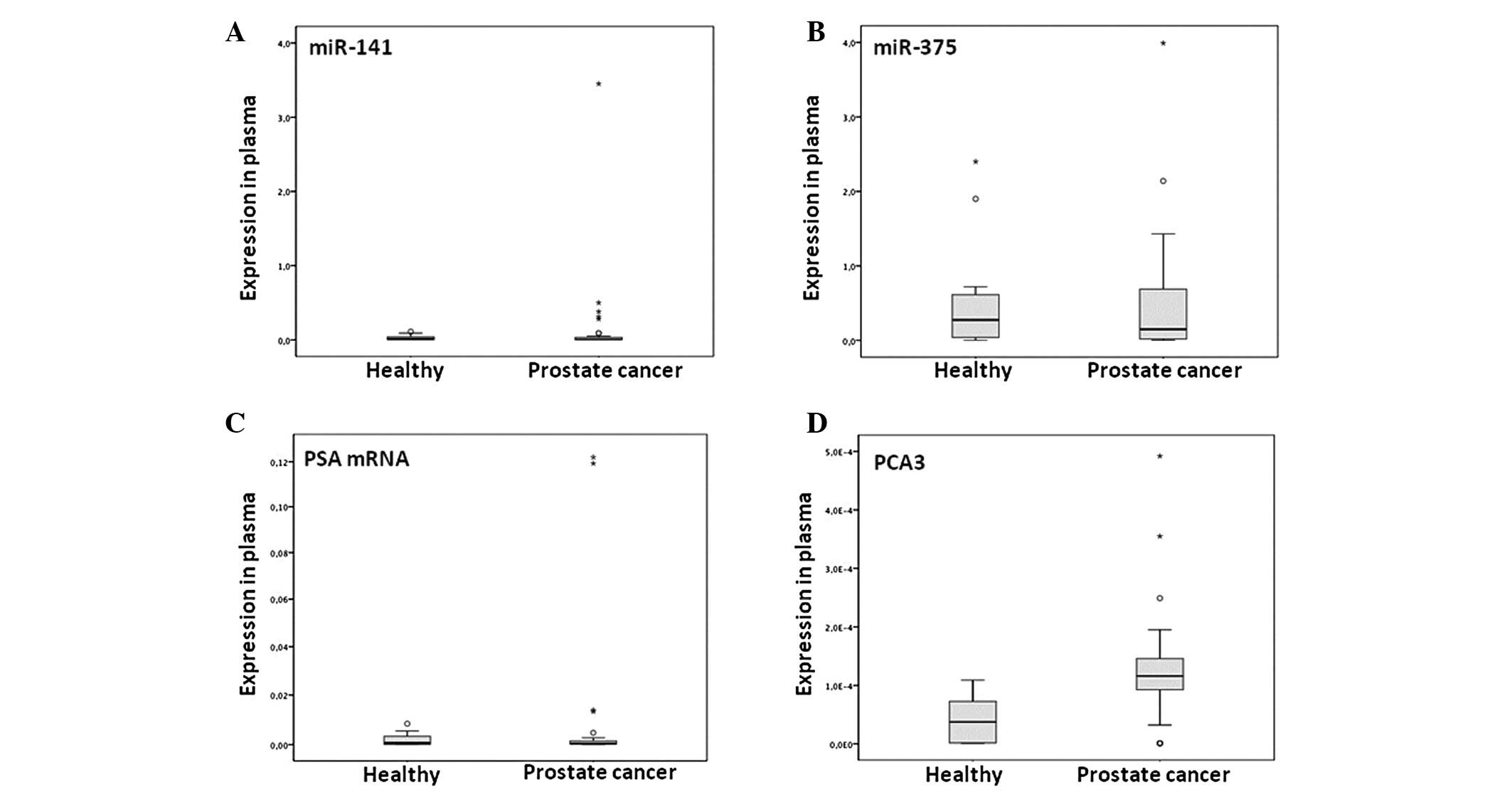|
1
|
Hayat MJ, Howlader N, Reichman ME and
Edwards BK: Cancer statistics, trends, and multiple primary cancer
analyses from the Surveillance, Epidemiology, and End Results
(SEER) Program. Oncologist. 12:20–37. 2007. View Article : Google Scholar : PubMed/NCBI
|
|
2
|
Leo S, Accettura C and Lorusso V:
Castration-resistant prostate cancer: targeted therapies.
Chemotherapy. 57:115–127. 2011. View Article : Google Scholar : PubMed/NCBI
|
|
3
|
Shariat SF, Scherr DS, Gupta A, Bianco FJ
Jr, Karakiewicz PI, Zeltser IS, Samadi DB and Akhavan A: Emerging
biomarkers for prostate cancer diagnosis, staging, and prognosis.
Arch Esp Urol. 64:681–694. 2011.PubMed/NCBI
|
|
4
|
Mitchell PS, Parkin RK, Kroh EM, Fritz BR,
Wyman SK, Pogosova-Agadjanyan EL, Peterson A, Noteboom J, O’Briant
KC, Allen A, Lin DW, Urban N, Drescher CW, Knudsen BS, Stirewalt
DL, Gentleman R, Vessella RL, Nelson PS, Martin DB and Tewari M:
Circulating microRNAs as stable blood-based markers for cancer
detection. Proc Natl Acad Sci USA. 105:10513–10518. 2008.
View Article : Google Scholar : PubMed/NCBI
|
|
5
|
Kosaka N, Iguchi H and Ochiya T:
Circulating microRNA in body fluid: a new potential biomarker for
cancer diagnosis and prognosis. Cancer Sci. 101:2087–2092. 2010.
View Article : Google Scholar : PubMed/NCBI
|
|
6
|
Kuner R, Brase JC, Sültmann H and Wuttig
D: microRNA biomarkers in body fluids of prostate cancer patients.
Methods. 59:132–137. 2013. View Article : Google Scholar : PubMed/NCBI
|
|
7
|
Yaman Agaoglu F, Kovancilar M, Dizdar Y,
Darendeliler E, Holdenrieder S, Dalay N and Gezer U: Investigation
of miR-21, miR-141, and miR-221 in blood circulation of patients
with prostate cancer. Tumor Biol. 32:583–588. 2011.PubMed/NCBI
|
|
8
|
Brase JC, Johannes M, Schlomm T, Fälth M,
Haese A, Steuber T, Beissbarth T, Kuner R and Sültmann H:
Circulating miRNAs are correlated with tumor progression in
prostate cancer. Int J Cancer. 128:608–616. 2011. View Article : Google Scholar : PubMed/NCBI
|
|
9
|
Bryant RJ, Pawlowski T, Catto JW, Marsden
G, Vessella RL, Rhees B, Kuslich C, Visakorpi T and Hamdy FC:
Changes in circulating microRNA levels associated with prostate
cancer. Br J Cancer. 106:768–774. 2012. View Article : Google Scholar : PubMed/NCBI
|
|
10
|
Nguyen HC, Xie W, Yang M, Hsieh CL, Drouin
S, Lee GS and Kantoff PW: Expression differences of circulating
microRNAs in metastatic castration resistant prostate cancer and
low-risk, localized prostate cancer. Prostate. 73:346–354. 2013.
View Article : Google Scholar : PubMed/NCBI
|
|
11
|
Waltering KK, Porkka KP, Jalava SE,
Urbanucci A, Kohonen PJ, Latonen LM, Kallioniemi OP, Jenster G and
Visakorpi T: Androgen regulation of microRNAs in prostate cancer.
Prostate. 71:604–614. 2011. View Article : Google Scholar
|
|
12
|
Xiao J, Gong AY, Eischeid AN, Chen D, Deng
C, Young CY and Chen XM: miR-141 modulates androgen receptor
transcriptional activity in human prostate cancer cells through
targeting the small heterodimer partner protein. Prostate.
72:1514–1522. 2012. View Article : Google Scholar
|
|
13
|
van Bokhoven A, Varella-Garcia M, Korch C,
Johannes WU, Smith EE, Miller HL, Nordeen SK, Miller GJ and Lucia
MS: Molecular characterization of human prostate carcinoma cell
lines. Prostate. 57:205–225. 2003.PubMed/NCBI
|
|
14
|
Ferreira LB, Palumbo A, de Mello KD,
Sternberg C, Caetano MS, de Oliveira FL, Neves AF, Nasciutti LE,
Goulart LR and Gimba ER: PCA3 noncoding RNA is involved in the
control of prostate-cancer cell survival and modulates androgen
receptor signaling. BMC Cancer. 12:5072012. View Article : Google Scholar : PubMed/NCBI
|
|
15
|
Gonzales JC, Fink LM, Goodman OB Jr,
Symanowski JT, Vogelzang NJ and Ward DC: Comparison of circulating
microRNA-141 to circulating tumor cells, lactate dehydrogenase and
prostate-specific antigen for determining treatment response in
patients with metastatic prostate cancer. Clin Genitourin Cancer.
9:39–45. 2011. View Article : Google Scholar
|
|
16
|
Neves AF, Dias-Oliveira JD, Araújo TG,
Marangoni K and Goulart LR: Prostate cancer antigen 3 (PCA3) RNA
detection in blood and tissue samples for prostate cancer
diagnosis. Clin Chem Lab Med. 51:881–887. 2012.PubMed/NCBI
|
|
17
|
Sun XY, Plouzek CA, Henry JP, Wang TT and
Phang JM: Increased UDP-glucuronosyltransferase activity and
decreased prostate specific antigen production by biochanin A in
prostate cancer cells. Cancer Res. 58:2379–2384. 1998.PubMed/NCBI
|
|
18
|
Montgomery RB, Mostaghel EA, Vessella R,
Hess DL, Kalhorn TF, Higano CS, True LD and Nelson PS: Maintenance
of intratumoral androgens in metastatic prostate cancer: a
mechanism for castration-resistant tumor growth. Cancer Res.
68:4447–4454. 2008. View Article : Google Scholar : PubMed/NCBI
|












